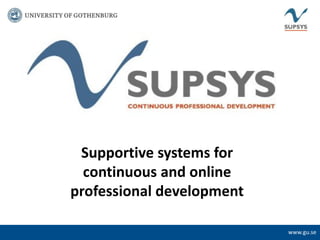Presentation Supsys-project -may2011
- 1. Supportive systems for continuous and online professional development www.gu.se www.gu.se
- 2. The SupSys project is developing an alternative to established education and forms of training in the shape of a supportive system that contribute towards solving companiesŌĆÖ and organisationsŌĆÖ need for a flexible supply of competence The challenge is how to develop a Support System based on contemporary media that continuously strengthens the individual's qualifications. www.gu.se www.gu.se
- 3. Informal learning, Virtual communities, CoP - Communities of Practice, Online learning communitiesŌĆ” Lieve Van den Brande, European Commission, DG Education and Culture, PPT, download 24 ŌĆÄeb ŌĆÄ 011 f 2 www.gu.se www.gu.se
- 4. Article: Supportive systems for continuous and online professional development Jobring,Svensson eLearning Papers n┬░ 22 (2010) http://bit.ly/SupSys2 www.gu.se www.gu.se
- 5. How? Based on Shared Interest Combine Formal and Informal learning Combine Individual and Collaborative www.gu.se www.gu.se
- 6. Potential target groups ŌĆó Co-workers in different SMEs with similar spheres of activity Examples: Financial managers in various SMEs, production managers in various SMEs ŌĆó Co-workers in major businesses, companies, or groups with similar spheres of activity Examples: Store managers in a major retail chain, HR staff in various municipalities. ŌĆó Individual professionals linked to the same industry without being geographically or mutually in competition Examples: Shoemakers, accountants, dentists, and farmers ŌĆó Members of trade associations, unions, and professional and industrial organisations. Examples: Teachers, consultants, therapists; Occupational groups in union organisations www.gu.se www.gu.se
- 7. Supsys work/learning group process www.gu.se www.gu.se
- 8. S www.gu.se www.gu.se
- 10. Ove Jobring, Dr., UNIVERSITY OF GOTHENBURG Department of Work Science ove.jobring@gu.se Phone +46 708142010 Box 705, SE-405 30 Gothenburg, Sweden, 2 The project http://bit.ly/Supsys-UnivGoth LinkedIn http://linkd.in/supsys www.gu.se www.gu.se










